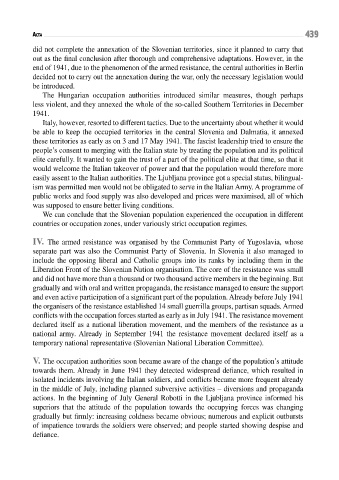Page 439 - Conflitti Militari e Popolazioni Civili - Tomo I
P. 439
439
aCta
did not complete the annexation of the Slovenian territories, since it planned to carry that
out as the final conclusion after thorough and comprehensive adaptations. However, in the
end of 1941, due to the phenomenon of the armed resistance, the central authorities in Berlin
decided not to carry out the annexation during the war, only the necessary legislation would
be introduced.
the Hungarian occupation authorities introduced similar measures, though perhaps
less violent, and they annexed the whole of the so-called Southern Territories in December
1941.
Italy, however, resorted to different tactics. Due to the uncertainty about whether it would
be able to keep the occupied territories in the central Slovenia and Dalmatia, it annexed
these territories as early as on 3 and 17 May 1941. The fascist leadership tried to ensure the
people’s consent to merging with the Italian state by treating the population and its political
elite carefully. It wanted to gain the trust of a part of the political elite at that time, so that it
would welcome the Italian takeover of power and that the population would therefore more
easily assent to the Italian authorities. The Ljubljana province got a special status, bilingual-
ism was permitted men would not be obligated to serve in the Italian Army. A programme of
public works and food supply was also developed and prices were maximised, all of which
was supposed to ensure better living conditions.
We can conclude that the Slovenian population experienced the occupation in different
countries or occupation zones, under variously strict occupation regimes.
iV. The armed resistance was organised by the Communist Party of Yugoslavia, whose
separate part was also the Communist Party of Slovenia. In Slovenia it also managed to
include the opposing liberal and Catholic groups into its ranks by including them in the
Liberation Front of the Slovenian Nation organisation. The core of the resistance was small
and did not have more than a thousand or two thousand active members in the beginning. But
gradually and with oral and written propaganda, the resistance managed to ensure the support
and even active participation of a significant part of the population. Already before July 1941
the organisers of the resistance established 14 small guerrilla groups, partisan squads. Armed
conflicts with the occupation forces started as early as in July 1941. The resistance movement
declared itself as a national liberation movement, and the members of the resistance as a
national army. Already in September 1941 the resistance movement declared itself as a
temporary national representative (Slovenian National Liberation Committee).
V. The occupation authorities soon became aware of the change of the population’s attitude
towards them. Already in June 1941 they detected widespread defiance, which resulted in
isolated incidents involving the Italian soldiers, and conflicts became more frequent already
in the middle of July, including planned subversive activities – diversions and propaganda
actions. In the beginning of July General Robotti in the Ljubljana province informed his
superiors that the attitude of the population towards the occupying forces was changing
gradually but firmly: increasing coldness became obvious; numerous and explicit outbursts
of impatience towards the soldiers were observed; and people started showing despise and
defiance.

